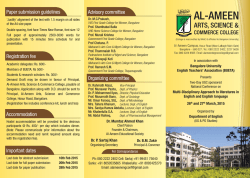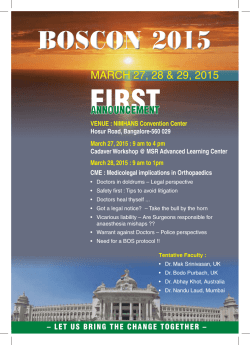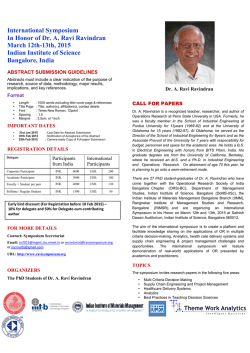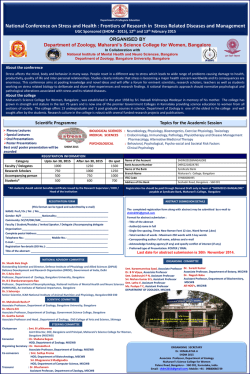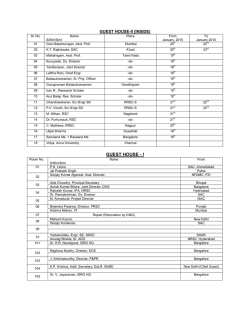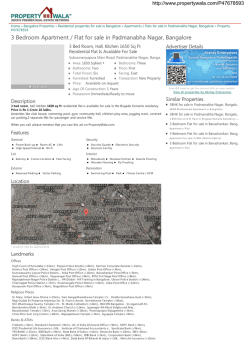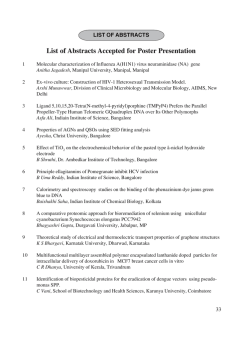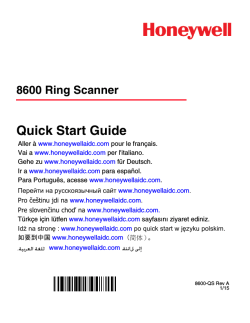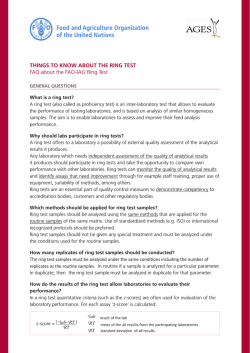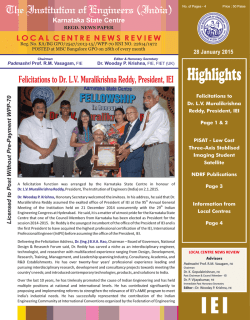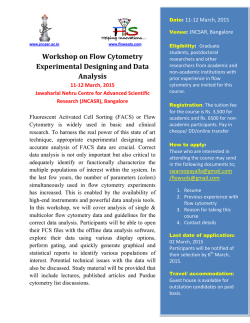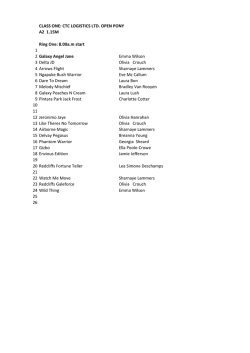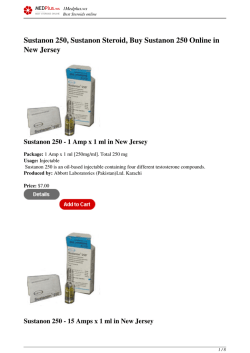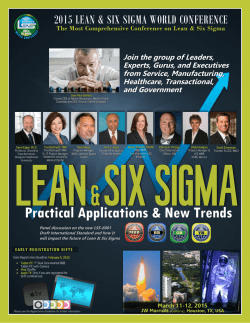
DRAFT MASTER PLAN - 2015 - Bangalore Development Authority
DRAFT MASTER PLAN - 2015 An Integrated Planning Approach . . . A a Tr Hou sing Sol id W aste Ind u stry Lan dU se rt po tr y s Slu ms us ic st ns m en s ie t i Sm al lI nd gi o L W at er Ag Na ricul tur tur e al Ar ea s Hi -T ec lat ion H Po pu er it ag e h . . . Towards a Vibrant International City Bangalore Development Authority Bangalore - An Emerging International City A s one of the world's fastest growing cities, Bangalore is experiencing a steady increase in population (3.25% current annual growth rate). Its population is likely to be 10 million by 2021. The growth is spurred by the advantages conferred on t h e C i t y b y entrepreneurial and intellectual capacity incubated through a series of private and government actions. Besides, Bangalore enjoys a favourable climate, a high quality of life, a cosmopolitan ambience and social diversity. The City has earned the titles of “IT Hub of Asia” and “Silicon Valley of India.” However, while the IT based formal sector accounts for 15% of its economy, the informal sector contributes 60-70%. Bangalore's advantages places it on the threshold of the status of an International City. A concerted effort towards developing new functions, especially high value service sectors, upgrading the City's infrastructure including transport, public amenities and logistics, and provision of housing options within the larger natural environment will contribute to the City's economic dynamism. About the Draft Master Plan - 2015 The first step towards planning for development in Bangalore was initiated with the Outline Development Plan (ODP), prepared by the Bangalore Development Committee. The Town and Country Planning Act, 1961, was enacted to enable preparation of development plans for settlements in Karnataka. ! ! ! ! ! ! ! ! ! 1952 - Bangalore Development Committee founded 1961 - Karnataka Town and Country Planning (KTCP) Act enacted 1963 - Outline Development Plan (ODP) submitted to Govt. 1965 - KTCP Act enforced 1972 - ODP approved and adopted under the KTCP Act 1961 1976 - BDA constituted 1984 - 1 CDP for 1985 approved 1995 - 2 CDP for 2005 approved 2005 - 3 CDP for 2015 prepared st nd rd The Bangalore Development Authority (BDA) is entrusted with the task of preparing a Comprehensive Development Plan (CDP) as per the KTCP Act. The KTCP Act requires that the CDP be revised every 10 years. Consequently, BDA's mandate is to update the Revised CDP of 1995. The Draft Master Plan - 2015, prepared under the KTCP Act, covers a Local Planning Area of 1306 sq. kms and consists of 387 villages, 7 City Municipal Councils (CMC) and 1 Town Municipal Council (TMC). It serves as the foundation for developing strategic plans and local area plans, and finally, designing neighbourhoods. Administrative areas map Legend Issues and concerns facing Bangalore today Like any growing city, Bangalore has its share of concerns that need immediate attention. Provision of housing, civic amenities and alternate modes of transportation, protection of natural areas and supply of adequate infrastructure facilities are some of the concerns. Traffic and transport What does the Draft Master Plan comprise of? The Draft Master Plan contains sets of maps and documents in five volumes. Strategic planning with a focus on urban management, and a clear definition and coordination of institutional roles is essential. Natural areas preservation Process Diagram The Plan is powered by state-of-the-art technology consisting of an innovative and robust spatial data infrastructure at the metropolitan level. It comprises of a Geographical Information System (GIS), a Management Information System (MIS) and comprehensive data models enabling a plan that is up-to-date. Volume 1 Volume 2 Volume 3 Volume 4 Volume 5 Master Plan Vision Document Existing Land Use Maps (for each Planning District) Proposed Land Use Maps (for each Planning District) Land Use Zonal Regulations Planning Districts Report Main Factors The Structure Plan - A conceptual diagram serving as a framework for future development in the City The plan considers the present situation, the various growth trends at work and future issues. It integrates key influencing factors including the City's natural environment, its heritage, and issues of economic efficiency and social equity. The Structure Plan is based on the governing principle of “Structured Continuity.” This principle directs that development in existing urbanized areas and new extensions must be “structured” spatially and functionally to avoid unmanaged urban sprawl. Existing urban patterns must be strengthened through urban renewal and proposed development must be “continued” by selective extension of already developed areas. This will avoid new developments in distant outskirts that are not serviced by infrastructure and transportation. This plan envisions that development will be spatially organized in: Ø Five concentric belts: st · 1 Belt - The core area consisting of the historic Petta, the Administrative Centre and the Central Business District; nd · 2 Belt - Peri-central area with older planned residential areas surrounding the core area; rd · 3 Belt - Recent extensions (2003) of the City flanking both sides of the Outer Ring Road, a portion of which lacks services and infrastructure facilities and is termed as a shadow area; th · 4 Belt - New layouts with some vacant lots and agricultural lands; and th · 5 Belt - Green belt and agricultural area in the City's outskirts including small villages. Ø Linearly along major radial roads (national/state highways) where there is a concentration of industrial, services and logistic activities. Ø Centres within the City which have high density compact urban development with a concentration of mixed uses that will serve the surrounding residential areas. The transportation strategy includes specific strategies for public and private transport infrastructure that will serve as an important tool to structure development. Vision 2015 The Vision 2015 map defines a framework and general directions to spatially delineate the areas where development is to be focused and promoted. It provides a strategic vision for the city and forms the basis for the Draft Master Plan. Principles 1. Respect the natural environment 2. Promote economic efficiency 3. Ensure social equity 4. Preserve historical heritage 5. Ensure efficient and affordable transport systems 6. Structure development in relation to a strategic transport network. BANGALORE Vision 2015 Master Plan 2005 - 2015 Salient Features of the Draft Master Plan Ø Redevelop dilapidated industrial lands and large-scale vacant properties through public-private partnerships. Local Planning Area (LPA) or Bangalore Metropolitan Area (BMA) - 1306 sq. kms Ø Area for development (conurbation area) - 786 sq. kms Ø Green belt and agricultural areas - 455 sq. kms Ø Projected population (for 2015 within BMA) - 8.84 million Ø Recognize mixed land uses while maintaining existing housing stock to create more livable communities with reduced reliance on the automobile, and to minimize urban sprawl while optimizing available infrastructure. Ø Main Recommendations Ø Maintain and strengthen the green belt to preserve the City's natural assets and biodiversity. This includes the: · Catchment area of the Tippagondanahalli Reservoir; · Ground water table; and · State forests. Ø Protect tanks and valley beds to: · Preserve natural drainage and ecological balance; · Prevent floods in low lying areas; · Refill the ground water table; and · Reduce dependence on Cauvery water. Ø Accommodate around 8.8 million people (3.25% current annual growth rate) by allowing urban development to the extent of the proposed Peripheral Road. Ø Promote a distinct Central Business District to enhance the image of Bangalore as an International City and make it the preferred destination for activities such as high-end offices and retail, and leading financial services. Ø Promote and upgrade the historic core area, Petta, to strengthen its position as a centre for formal and informal economy. Ø Promote urban renewal in the areas around the core area to provide good housing stock and to reduce the need to travel. Ø Structure and focus development along the major radiating corridors to promote them as privileged destinations for office buildings, service activities, commercial complexes and highend residential buildings. Ø Promote logistic activities in areas with good accessibility by various modes of transportation such as rail, road and air to facilitate a synergy between the production functions, the services and transport sectors. Ø Promote Hi-tech development by earmarking land for 375,000 new jobs related to IT, software, electronics, telecommunications and other emerging knowledge-based industries by the year 2015. Ø Allocate land to encourage new small and medium scale industries that will diversify and strengthen the industrial base and enhance the state economy. Ø Develop city scale Sub-Centers that serve as activity nodes. Ø Develop transport interchange hubs with mixed-use activities at the junctions of main corridors, ring roads and railway lines to decentralize bus and railway stations by moving them out of the City centre. Ø Facilitate an integrated system of transport that serves as a framework for new development as well as offers affordable choices for transport by: · Developing a Mass Public Transport System (MPTS); · Promoting a Commuting Railway System (CRS); and · Promoting multi-articulated dedicated bus lanes along the main axes. Ø Set up a road network to ensure proper connectivity of the underdeveloped areas in the outskirts of the City. Ø Implement a new Core Ring Road along with the Intermediate Ring Road, Outer Ring Road and proposed Peripheral Road, to reduce traffic congestion. Land Use Zones and Zonal Regulations The Land Use Zonal Regulations for the Bangalore Local Planning Area (LPA) are prepared under Clause (iii) of Sub-section (2) of Section 12 and 21 of the Karnataka Town and Country Planning (KTCP) Act. Details are available in Volume 4 of the Draft Master Plan - 2015. The Land Use and Developmental Zones of the Draft Master Plan are organized under three categories. LAND USE ZONES I Main Areas Category II Specific Areas Category III Constraint Areas Category I. Main Areas Category The Main Areas Category consists of 16 zones each containing specific regulations and rules that apply to selected areas. The 16 zones are applied to five selected areas of the LPA based on their characteristics, urban pattern and development potential. 16 II. Specific Areas Category Areas within the LPA which have specific land uses that are not included under the Main Areas Category come under the Specific Areas Category. Development within these areas requires coordination and consultation with the concerned Authority or government body in order to comply with the larger framework of the Draft Master Plan - 2015. 1 III. Constraint Areas Category Constraint Areas Category covers areas within the LPA which have restrictions on development and specific criteria for development around and within them. The restrictions are commonly governed by specific Acts or regulations. They include: Objectives of the new land use zones and zonal regulations: · · · · To safeguard public interest; To strengthen and respond to the City's complexity by being anticipatory and responsive, and making realistic regulations; To create flexible land use zones, and To facilitate implementation. Salient features of the Land Use Zonal Regulations Land use zones Ø A Protected Lands Zone which includes lakes, valleys, tanks and national parks and forests is proposed to preserve natural areas. Ø A Heritage Zone is introduced to protect and conserve built and Natural heritage. Ø Planning schemes such as Coordinated Planning Schemes and Town Planning Schemes involving public private partnerships Are introduced. Ø A Hi-tech zone that permits industrial format non-polluting industries such as services industries, campus styled related Information Technology, Biotechnology etc, and self contained facilities is proposed. Ø Logistic/ transportation zones mainly comprising of cargo Warehousing, loading and unloading platforms are proposed for efficient transportation. Ø Disorganized traffic intersections and transport related areas are delineated as Transport and Utility Perimeters for micro level planning and design by concerned authorities. Ø Areas deficient in infrastructure and connectivity are delineated as Area Improvement Perimeters for facilitating action by concerned authorities. Ø Each zone has permissible main uses and ancillary uses. Ø Depending on the zone, mixed land use is permitted subject to necessary conditions. Zonal regulations Ø Transfer of Development Rights and Premium Floor Area Ratio (FAR) is introduced. Ø The FAR and Ground Coverage (GC) are in relation to the plot size and the road widths specific to each zone. + Ø For housing projects and non residential development plans, the size of the plot dictates the FAR, GC and other regulations such as the relinquishment and allocation of amenities within private developments. Ø Setbacks are prescribed as percentages in relation to site dimensions for buildings less than 15.0 m height. Ø Jointive form of buildings (with common walls) is permissible in old areas subject to necessary conditions. Ø Tower and podium construction is permissible for plots greater than 5000 sq. m along MG Road. Ø For more than one building on a given site, the setbacks between the two buildings are 1/3rd the height of the taller of the two. Ø To facilitate scaled buildings the length of building is linked to the height of the building. Ø Parking norms are relaxed in dense areas, where individual parking is not feasible through payment of fees. There is a focus on community parking provision. Ø Parking under stilts and basement parking are not included for calculating the FAR. Ø In case of land for residential sub-division smaller than 10000 sq. m, Civic Amenities (CA) and open spaces may be dispensed in lieu of a fee. Ø Developable area within a given sub-division layout is enhanced to 55% of the total area. Ø For every 5.0 acre of development, a 12.0 m road connecting the adjacent plot or as determined by the authority is made public access. Ø Modification of CA percentage within sub-division plans is possible in case of easements, RoWs, etc. Ø Parks and open spaces in the layouts are leased to the Associations for maintenance. Institutional procedures Ø Number of No Objection Certificates is proposed to be reduced by introducing a one stage clearance of projects. Ø A consultative process involving public and private stakeholders Is proposed for large projects over 15.0 acres in BMP and 25 acres beyond BMP limits. + = Proposed Land Use Map Proposed Land Use Map Based on the ward boundaries, existing physical features, and the analysis of the existing development trends within the City, 47 Planning Districts (PDs) have been delineated to implement the Draft Master Plan. The planning districts are organized in three rings: 1st Ring: The core area PDs 1.01 to 1.07 2nd Ring: The developed urban areas surrounding the core area PDs 2.01 to 2.18 3rd Ring: The urban extension areas in the City's outskirts Pds 3.01 to 3.22 The land use zones are applied to each planning district after conducting a thorough analysis and study of the area's characteristics and growth trends, and considering the development stakes and major directions issuing from the Vision. Land use and transportation proposals are mapped and projects/urban management issues are identified for implementation at the planning district level. D etails are available in Volume 3 and 5 of the Draft 1st Ring Planning district boundaries 2nd Ring 3rd Ring Example - Proposed land use map at planning district level Bangalore Development Authority Send Us Your Feedback! Contact: The Commissioner Bangalore Development Authority T. Chowdaiah Road, Kumara Park West, Bangalore 560020 Phone: 91-80-23360843 Fax: 91-80-23345799 E-mail: [email protected] URL: www.bdabangalore.org Visit: The Bangalore Master Plan 2015 exhibition at: The Auditorium Hall, 2nd Floor, “YAVANIKA,” Nrupatunga Road, KR Circle, Bangalore 560 001. Dates: 27th June to 26th August 2005 Time: 10:00 AM to 5:00 PM (on all working days) We are eagerly looking forward to your reaction.
© Copyright 2026
